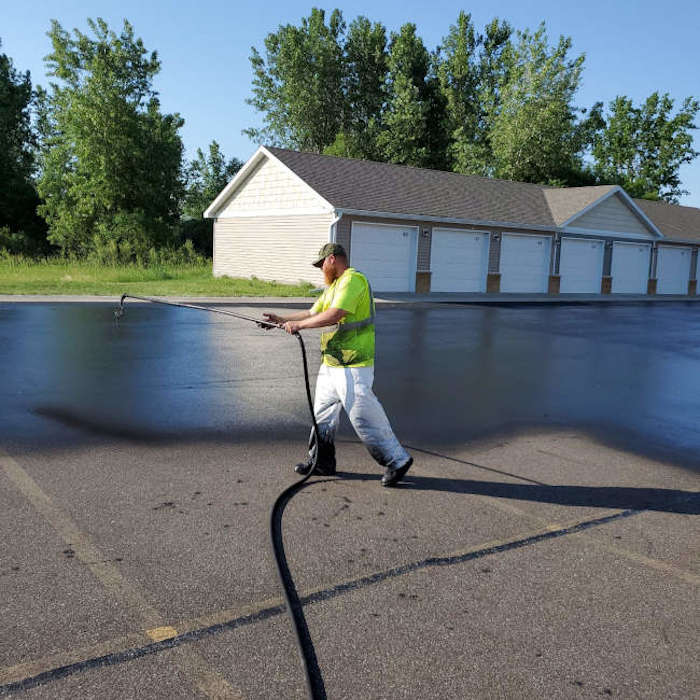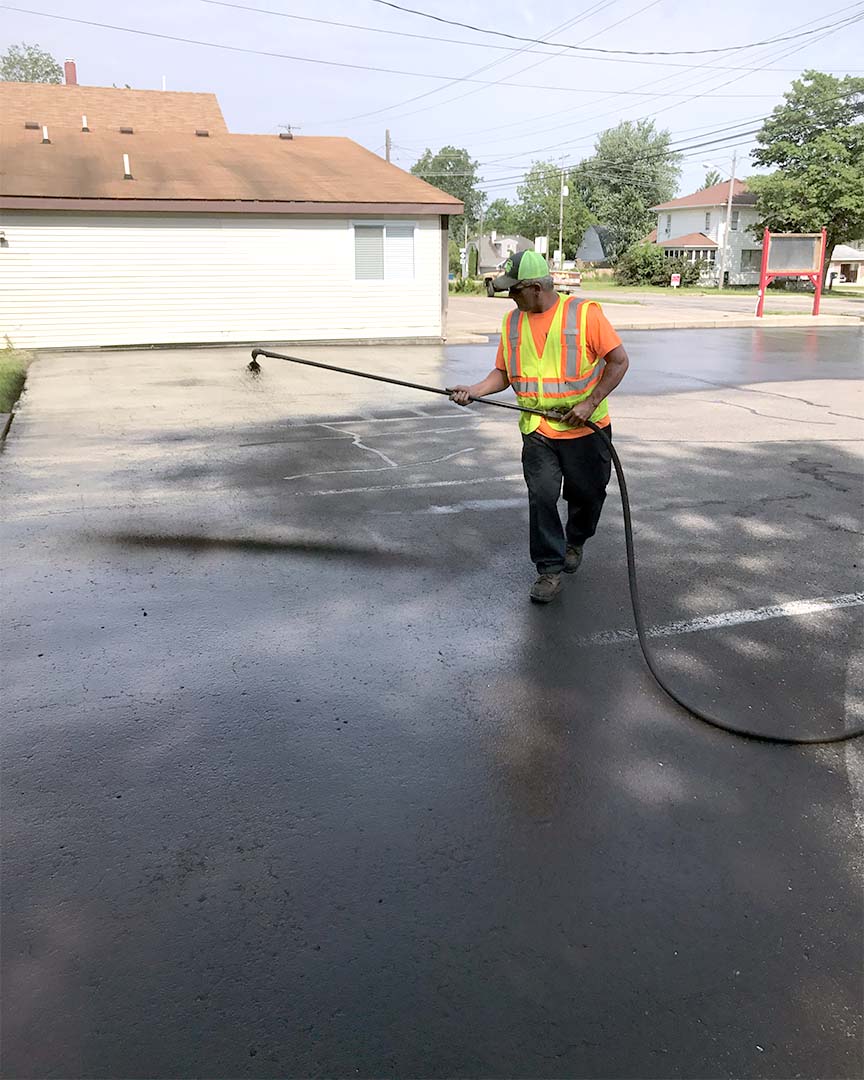Raise Commercial Allure: Hot Mix Asphalt Sealing for Angled Parking Lots
Raise Commercial Allure: Hot Mix Asphalt Sealing for Angled Parking Lots
Blog Article
Hot Mix Asphalt: A Lasting Option for Sidewalk
Hot Mix Asphalt (HMA) has actually become a leading lasting choice for sidewalk services, providing a myriad of cutting-edge innovations and ecological advantages. Its capability to minimize and reuse materials power consumption offers a compelling situation for its fostering in road building and construction jobs. The long-lasting efficiency and durability of HMA make it a recommended alternative for infrastructure advancement. As the demand for green building methods grows, discovering the subtleties of HMA's sustainability can provide important understandings into the future of sidewalk options.
Environmental Benefits of Hot Mix Asphalt

Furthermore, Hot Mix Asphalt helps to mitigate urban heat island effects. Its dark shade soaks up sunlight, reducing the amount of warm mirrored back into the atmosphere compared to lighter-colored sidewalks. This can decrease ambient temperatures in city locations, decreasing the need for air conditioning and ultimately decreasing energy usage.
In enhancement, Warm Mix Asphalt adds to boosted stormwater administration. Its permeable nature permits water to infiltrate the sidewalk and recharge groundwater products, lowering overflow and the risk of flooding. These ecological advantages make Hot Mix Asphalt a lasting choice for paving roadways and freeways.
Energy Effectiveness in HMA Manufacturing
Is energy performance an essential factor in the production of Warm Mix Asphalt (HMA)? Energy plays a substantial role in the production of HMA, affecting both expense and environmental sustainability. One key element of power efficiency in HMA production is the use of warm mix asphalt (WMA) innovations.
Moreover, developments in plant modern technologies have actually led to even more energy-efficient HMA production procedures. By enhancing energy use in HMA production, the sector can reduce its carbon impact while keeping high-quality pavement products.
Recyclability of Hot Mix Asphalt
The recyclability of Warm Mix Asphalt (HMA) is an essential aspect of its sustainability and lasting environmental impact. HMA is among one of the most recycled materials in the USA, with over 100 million lots of recovered asphalt pavement (RAP) being reused yearly in brand-new pavement building. Recycling HMA uses numerous ecological benefits, such as lowering the demand for virgin materials, decreasing power consumption throughout production, and decreasing the amount of waste sent out to landfills.
The process of recycling HMA involves milling the existing pavement, squashing it into smaller pieces, and blending it with brand-new accumulation and asphalt binder to produce a recycled mix. On the whole, the recyclability of HMA plays a significant role in advertising lasting practices within the sidewalk sector.

Long-Term Performance of HMA
Asphalt sidewalks show toughness and resilience over an extended duration, showing visite site the long-term efficiency of Warm Mix Asphalt (HMA) The longevity of HMA can be credited to its ability to stand up to rush hour loads, severe weather, and the results of aging. Studies have revealed that properly designed and correctly constructed HMA sidewalks can last for two decades or more with regular maintenance. The key to taking full advantage of the long-term efficiency of HMA depends on utilizing top quality products, complying with best practices in construction, and executing efficient maintenance strategies. Appropriate water drainage, regular inspections, and prompt fixings are important for preserving the architectural integrity of HMA pavements over time. Furthermore, developments in HMA modern technology, such as using polymer-modified binders and warm mix asphalt, have better improved the durability and durability of HMA pavements. By prioritizing quality building and construction and upkeep methods, HMA continues to confirm itself as a economical and lasting service for durable sidewalk facilities.

HMA: Toughness and Sustainability
Showing both durability and sustainability, Warm Mix Asphalt (HMA) has ended up being a cornerstone in the construction of durable sidewalk infrastructures - commercial parking lot paving. HMA's longevity originates from its ability to endure hefty tons, severe weather, click here for info and high web traffic quantities, making it a dependable selection for streets, highways, and airport terminal runways. The make-up of HMA, which generally consists of accumulations, binder, and filler, plays a crucial role in boosting its durability and resistance to put on and tear
Furthermore, HMA's sustainability depends on its recyclability and energy-efficient production procedure. The ability to reuse recovered asphalt pavement (RAP) in new HMA blends reduces the demand for virgin materials and minimizes the ecological influence of pavement construction and maintenance. Furthermore, the power effectiveness of creating HMA hinges on its lower mixing temperatures compared to other sidewalk products, resulting in reduced energy consumption and greenhouse gas exhausts.
Final Thought
To conclude, hot mix asphalt (HMA) uses a sustainable service for sidewalk with its ecologically pleasant characteristics. HMA's recyclability, energy performance in production, and long-lasting sturdiness make it an eco-friendly choice for roadway building. By conserving natural deposits, reducing waste, and lowering greenhouse gas emissions, HMA plays a critical function in advertising sustainability in framework growth. Its capability to minimize urban warmth island impacts even more emphasizes its importance in producing resistant and ecologically mindful pavement systems.
HMA is one of the most recycled products in the United States, read more with over 100 million loads of redeemed asphalt pavement (RAP) being recycled yearly in new pavement building.The process of recycling HMA includes crushing the existing pavement, crushing it into smaller pieces, and mixing it with brand-new aggregate and asphalt binder to produce a recycled mix.Asphalt sidewalks show longevity and strength over an extensive duration, showing the long-term performance of Hot Mix Asphalt (HMA) Furthermore, improvements in HMA technology, such as the usage of polymer-modified binders and warm mix asphalt, have better enhanced the longevity and long life of HMA sidewalks. The capacity to reuse redeemed asphalt sidewalk (RAP) in new HMA blends reduces the demand for virgin materials and reduces the ecological impact of sidewalk construction and upkeep.
Report this page